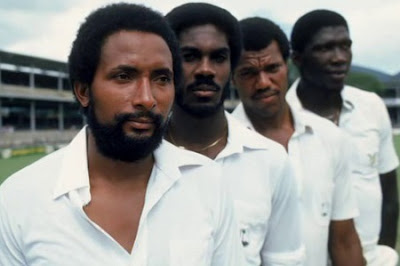Sports Kaleidopedia Feature
It seems eons ago when the cricket teams used to have a battery of fast bowlers on whose shoulders the fate of a match rested upon. Gone are the days when there used to be an even competition between the bat and the ball, when the pitches had enough moisture to encourage the pacers to bowl their hearts out, when the edges and the miss timed strokes didn't clear the boundaries, when the pacers didn't hesitate to bend their backs and when the rules were not partial towards the batsmen.
 Those were the good old days when a Jeff Thomson bouncer hit the top of the sight screen, when West Indian wicket keepers stood right next to ropes for the pacers, when Jeff Thomson's deliveries defied the speed limits and when batsmen courageously hooked and pulled without helmets. Many regard that period as the golden era of cricket.
Those were the good old days when a Jeff Thomson bouncer hit the top of the sight screen, when West Indian wicket keepers stood right next to ropes for the pacers, when Jeff Thomson's deliveries defied the speed limits and when batsmen courageously hooked and pulled without helmets. Many regard that period as the golden era of cricket.
The era saw sparkling batsmen whose skills bettered the quality of their bats, ferocious bowlers whose deliveries had more venom than their sledging, phenomenal all-rounders who were equally skilled with bat and ball, zealous wicket keepers whose agility overshadowed their chattering. Those were the days of the 'Gavaskars', the 'Greenidges', the 'Richards', the 'Boycotts', the 'Lloyds', the 'Sobers', the 'Holdings', the 'Garners', the 'Roberts', the 'Hadlees', the 'Marshalls', the 'Devs', the 'Khans', the 'Bothams', the 'Marshes', the 'Murrays', and the 'Dujons'.
Since then, the game has come a long way, growing further as a commercial sport and hasn't failed to produce great batsmen like Tendulkar, Lara, Ponting, Hayden, Dravid and others. It has even managed to produce world class spinners like Warne, Murali, Kumble and legendary medium pacers like Mcgrath, Akram, Pullock and others. But the breed of express bowlers that has been the game's greatest legacy is facing extinction.
 Nowadays, one hardly sees a match (especially a test match) won by a genuine speedster, most of whom are forced to reduce their pace owing to the averse cricketing laws and career shortening injuries (due to lack of rest). Even the pitches are laid and maneuvered in such a manner that they offer no assistance to a pacer, even in the initial overs, deflating the very spirit and zeal which drives an express bowler, forcing him to run for cover.
Nowadays, one hardly sees a match (especially a test match) won by a genuine speedster, most of whom are forced to reduce their pace owing to the averse cricketing laws and career shortening injuries (due to lack of rest). Even the pitches are laid and maneuvered in such a manner that they offer no assistance to a pacer, even in the initial overs, deflating the very spirit and zeal which drives an express bowler, forcing him to run for cover.
The game's ruling body, the ICC is mostly responsible for the current disheartening scenario and the plight of the fast bowlers. It injected the game with commercially favorable rules which are extremely hostile to Fast Bowling like the restriction on short pitched bowling, stringent wide bowl and no bowl rules, powerplays, free hits, the over rate criteria, etc. Youngsters no longer dream of being a fast bowler, as they don't want to suffer the fate of an express bowler.
The Cricketing Boards are also least supportive of the rare breed of pacers, not taking the necessary measures to nurture the talent of those gifted with raw pace and instead inveigling them to cut down on their pace in order to prolong their careers (so that over rate and extras can be taken care of) thereby catering to the desires of ICC. It's time that shackles be broken and necessary steps be taken to revive the dying art of fast bowling, giving special attention to the existing breed (instead of cashiering them away), so that the game is not robbed of its greatest legacy.
- Murtaza Ali Khan










